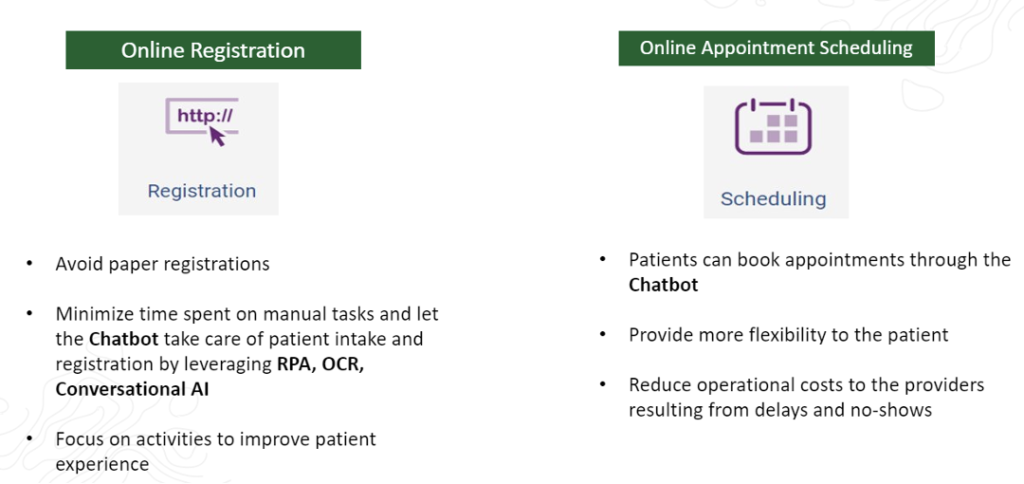The Patient Journey
The days of sitting in a waiting room filling out multiple forms and waiting to be called back to an exam room is swiftly becoming a thing of the past. Patient expectations for convenient access continue to grow as COVID-19 created new barriers to patient care. Patients expect to self-schedule and change appointments, find answers to simple health questions, and complete registration without playing phone tag with healthcare staff or messing with papers. Patient front door access points that are prime for digitization are appointment scheduling, automated waitlists, patient registration and intake.
A patient’s journey often starts with registration and appointment scheduling. Currently, this process is highly manual and time consuming. The registration process is usually completed in person or on paper resulting in huge operational costs to the provider. These outdated and inconvenient practices can contribute to patient appointment no-shows and last-minute cancellations. According to the National Center for Biotechnology Information, missed appointment rates range from 10% to 50% across healthcare settings in the world with an average rate of 27% in North America. Most times this results in follow up calls and rescheduling. Chief Marketing Officer of SCI Solutions, Jamie Gier, stated in an article in Health Management Technology that additional work by front office staff combined with unused appointment blocks costs the US healthcare system a staggering $150 billion per year. This is creating a negative impact on patient retention, patient experience, patient data collection, and most importantly patient continuity of care resulting in overstaffing or unnecessary clinical and front office staffing creating reduction in quality of care and lost revenue.
The loss in revenue can vary quite a bit from organization to organization. If this increasing problem is not addressed, a single medical practice can lose as much as $40,000 to $60,000 per year due to appointment cancellations and no-shows. Any size healthcare organization with multiple practices and outpatient department are potentially losing hundreds of thousands if not millions of dollars each year.
Overview of Intelligent Automation
Intelligent Automation (IA) can be leveraged to improve end-to-end patient experience and productivity of the healthcare staff by automating repetitive tasks and enabling them to focus on activities that add value to the organization. Intelligent Automation is a combination of Robotic Process Automation (RPA) and Artificial Intelligence (AI) technologies which together empower end-to-end business process automation and accelerate digital transformation. While RPA tends to focus on automating repetitive and rules-based processes, Intelligent Automation incorporates intelligence through Artificial intelligence (AI), Machine Learning (ML), Optical Character Recognition (OCR), Natural Language Processing (NLP), Conversational AI, Analytics, and Intelligent Document Processing (IDP).
Robotics Process Automation (RPA) can help automate and simplify the burdensome healthcare tasks such as managing inventory, entering repetitive data, digitizing patient files, patient registration, scheduling appointments, billing, and processing claims.
Simplify and automate patient registration, appointment scheduling and check-in procedures through Intelligent Automation

Using DU Chatbot New Patient Registration Virtual for Appointments
Payoffs from an Automated Digital Front Door
Better Patient Access: Provides easy access to patients to complete the registration process, schedule appointments as per their convenience resulting in reduced no-shows, go paperless and comply better with regulatory norms.
Fewer Gaps in Care: A powerful digital front door to any organization makes it possible to reduce the gaps in care by offering access to data to get patients back on the schedule with their care plans, chronic disease management, and preventive health.
Higher Patient Retention: Organization’s digital front door has the potential to not only attract new patients but also retain existing patients as it offers a platform to increase patient engagement and experience.
Improved Provider Bottomline: Digitizing and automating patient intake process results in less data errors leading to accurate claim filing and decreased claim denials, write-offs.
The Art of the Possible for the Patient Experience
Automating patient registration, appointment scheduling and initial condition assessment is the first step in improving the overall patient experience as these the key outcomes tied to the end-to-end patient experience:
- This also dramatically increases the amount of beneficial interaction and coordination between the provider and the patient.
- Sets a strong foundation to further automate downstream processes such as prior-authorization, contactless payment, medical coding, and claim submission.
- COVID has opened doors to Telehealth which is more accessible when combined with strategies like self-scheduling and contributes to operational savings.
- In addition, intelligent automation can help generate insights to the providers to address Social Determinants of Health (SDOH) and provide Value Based Care.
*SDOH – Social Determinants of Health are the socio-economic factors that influence health outcomes.
*Value Based Care aims to improve the quality and outcomes for patients.
Healthcare industry has an incredible opportunity to leverage intelligent automation to reduce costs and combat healthcare inequities.


